What Is a Garden Arbor and Why Should You Add One to Your Landscape
A garden arbor is an architectural structure typically consisting of two side supports connected by an overhead framework, creating a passageway or shaded area in your outdoor space. Unlike pergolas which cover larger areas, arbors are more compact and often serve as entranceways or focal points. You’ll find arbors crafted from various materials including wood, metal, vinyl, and even bamboo, each offering unique aesthetic qualities. Adding an arbor to your industry delivers multiple benefits: it creates visual interest by adding vertical dimension, defines transitions between different garden areas, supports climbing plants like roses or clematis, offers partial shade for relaxation, and instantly enhances your property’s curb appeal. Whether you’re looking to create a romantic garden entrance, highlight a pathway, or establish a charming seating nook, an arbor provides both beauty and function while reflecting your personal style and complementing your home’s architecture.
10 Classic Wooden Garden Arbor Ideas for Traditional Spaces
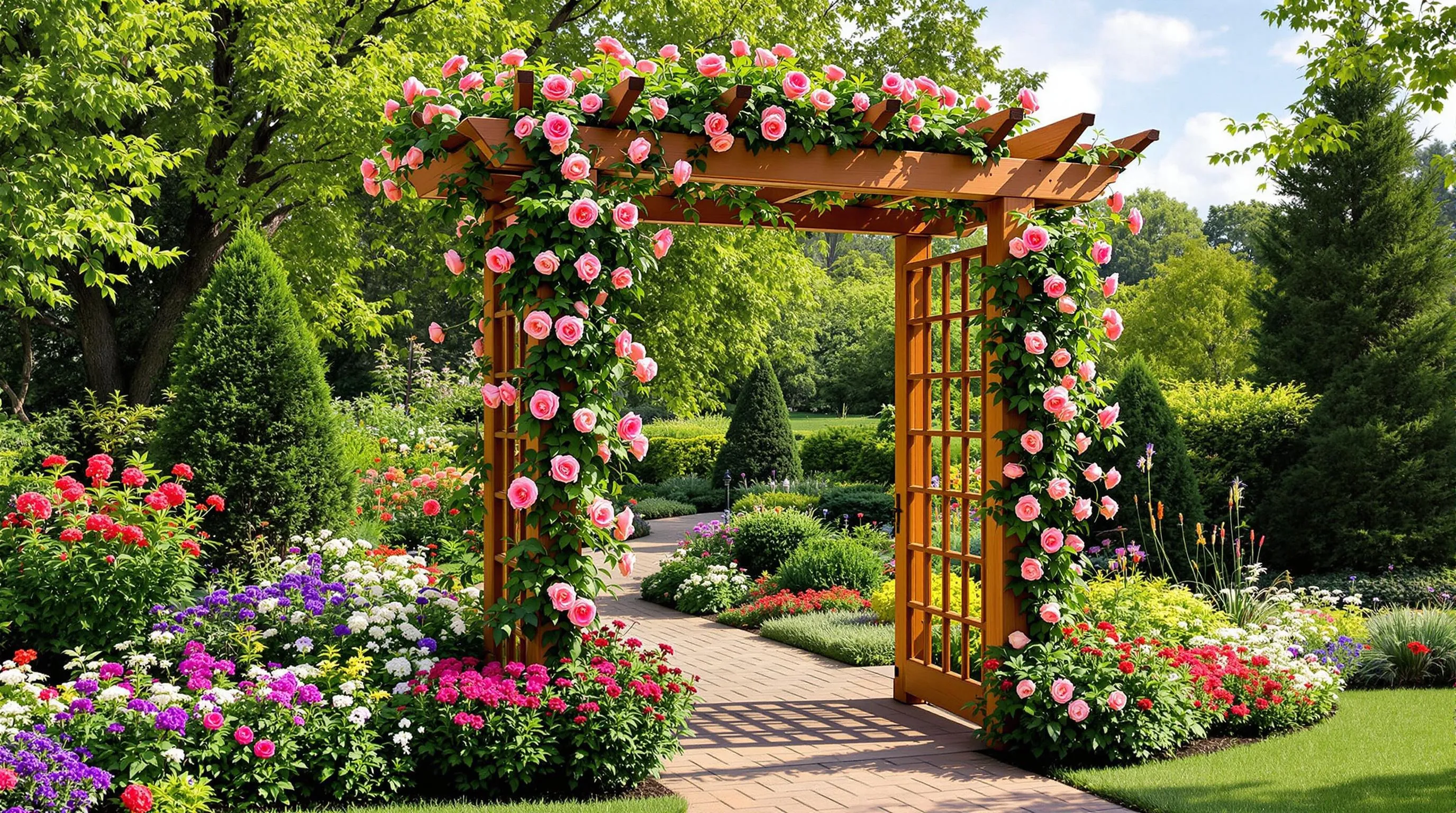
Wooden arbors bring timeless charm to traditional landscapes, offering both structural elegance and natural warmth. These classic designs enhance garden entryways and pathways while complementing traditional home architecture.
Cedar Garden Arbors for Durability and Beauty
Cedar garden arbors stand out as premier choices for traditional spaces thanks to their exceptional durability and rich, warm aesthetics. The natural oils in cedar repel insects and resist rot, making these arbors practical long-term investments that require minimal maintenance. You’ll appreciate how cedar weathers to a distinguished silver-gray patina over time while maintaining its structural integrity. For maximum visual impact, consider designs with lattice sides that provide ample support for climbing roses or clematis. Cedar arbors with built-in benches create inviting rest spots where you can enjoy your garden’s fragrance and beauty throughout the seasons.
Rustic Pergola-Style Arbors for Country Gardens
Rustic pergola-style arbors make perfect statement pieces for country gardens, combining architectural presence with rustic charm. These wider, more substantial structures feature thicker posts and crossbeams with visible joinery that showcases traditional craftsmanship. You can enhance their country appeal with decorative details like curved braces or hand-carved embellishments. Plant climbing wisteria, grapes, or honeysuckle to soften the wooden framework and create dappled shade beneath. These arbors work beautifully as transitions between different garden rooms or as focal points over garden paths, particularly when paired with informal plantings that emphasize their relaxed, countryside aesthetic.
7 Metal Garden Arbor Designs That Combine Strength and Elegance
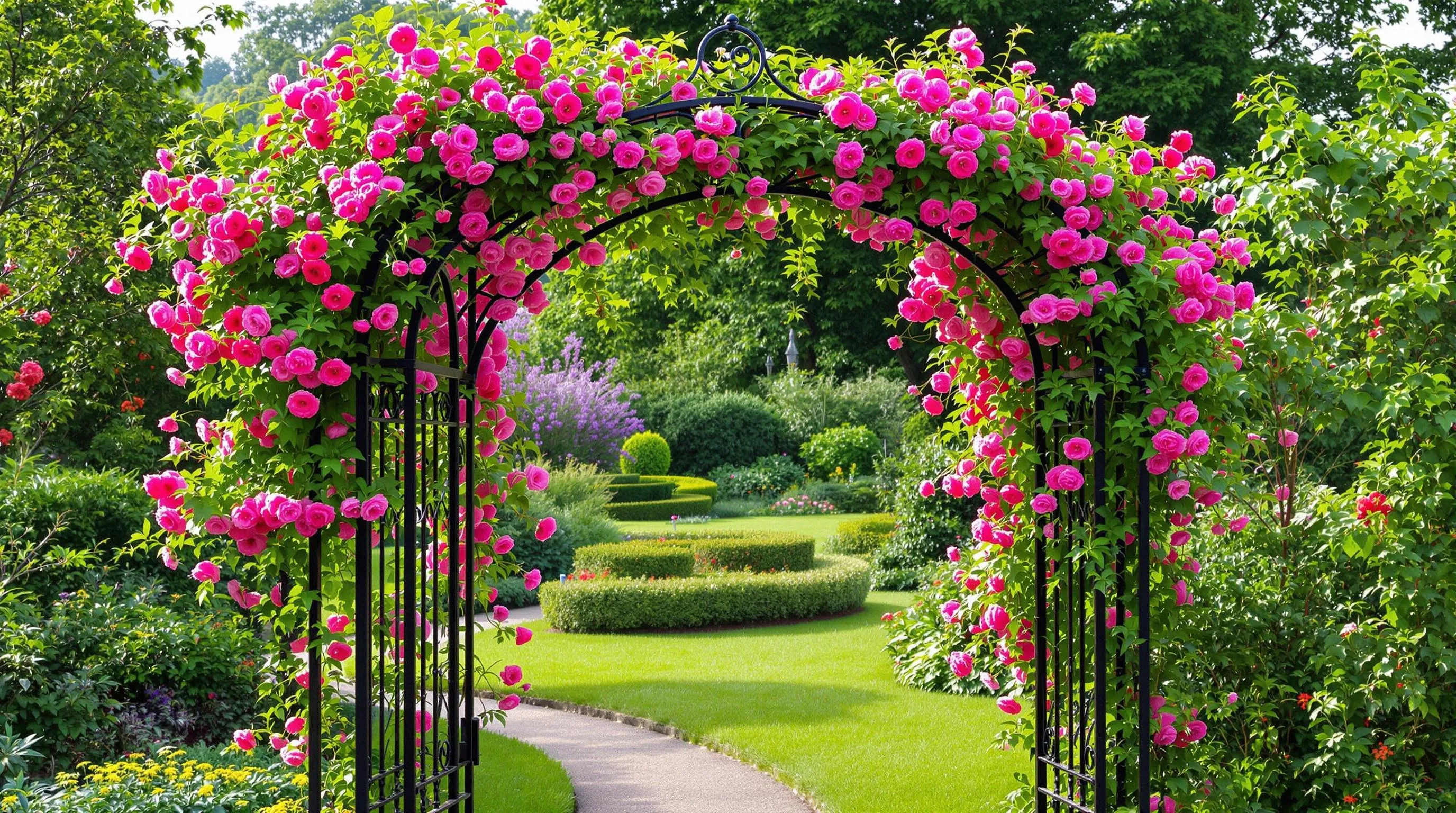
Metal garden arbors offer exceptional durability while adding sophisticated style to your outdoor space. These structures stand the test of time while creating stunning garden entrances and pathways. Here are seven metal arbor designs that perfectly balance strength with elegance:
Wrought Iron Arbors for Victorian-Inspired Gardens
Wrought iron arbors bring timeless elegance to classic garden settings with their intricate scrollwork and ornate details. These sturdy structures harken back to Victorian garden design with decorative finials, curling embellishments, and elegant arches that create a romantic atmosphere. You’ll find they’re particularly striking when roses, clematis, or wisteria weave through the framework, creating a living sculpture that enhances the arbor’s graceful lines. Even though their delicate appearance, wrought iron arbors provide exceptional durability, often lasting for decades with minimal maintenance beyond occasional rust prevention treatments.
Modern Metal Arbors for Contemporary Landscapes
For sleek, minimalist gardens, modern metal arbors offer clean lines and architectural interest that complement contemporary home designs. These arbors typically feature powder-coated steel or aluminum in matte black, charcoal, or metallic finishes that create bold silhouettes against greenery. Many modern designs incorporate geometric patterns, asymmetrical elements, or industrial-inspired details that serve as artistic focal points even without plant coverage. Their weather-resistant qualities make them practical choices for exposed locations, while their structural simplicity provides the perfect backdrop for statement plants or dramatic lighting installations.
Copper and Bronze Arbors for Aging Beauty
Copper and bronze arbors develop a stunning patina over time, transforming from bright metallic hues to rich verdigris tones that blend beautifully with garden surroundings. These premium metal options offer a living finish that evolves with your industry, creating a one-of-a-kind structure that becomes more beautiful with age. The natural antimicrobial properties of copper also discourage algae growth, making these arbors particularly suitable for shaded or humid garden areas where maintenance can be challenging.
Metal and Wood Combination Arbors
Hybrid metal and wood arbors bring together the best of both materials—the warmth of natural wood with the strength and longevity of metal framing. These versatile designs typically feature metal structural elements with cedar, redwood, or teak accents that create visual interest and texture. You’ll appreciate how these combination arbors adapt to various garden styles, from rustic to transitional, while offering the structural integrity of metal with the organic appeal of wood.
Arched Metal Tunnel Arbors
Create a dramatic garden passage with arched metal tunnel arbors that form an immersive walkway experience. These extended structures, often featuring multiple connected arches, provide the perfect support for climbing plants to create a living tunnel effect. When covered with flowering vines like jasmine, honeysuckle, or climbing roses, these arbors transform ordinary garden paths into enchanted corridors that engage all the senses—visual beauty, fragrance, and the changing play of light and shadow.
Decorative Metal Dome Arbors
Dome-shaped metal arbors create a distinctive focal point with their rounded silhouettes that stand out from traditional flat-topped designs. These architectural elements often feature intricate latticework or geometric patterns that cast beautiful shadow patterns on the ground below. You’ll find these arbors particularly effective in formal garden settings where their symmetrical shape complements structured plantings and defined pathways, creating a sense of balance and harmony.
Industrial Metal Arbors with Weathered Finishes
Embrace the trend of industrial garden design with arbors featuring raw steel, weathered patinas, or distressed metal finishes. These rugged structures incorporate elements like visible rivets, gears, or repurposed metal components that add character and historical interest to contemporary landscapes. Their deliberately aged appearance provides instant maturity to new garden installations, while their substantial construction ensures they’ll continue to weather beautifully for years to come.
8 Climbing Plant Combinations to Transform Your Garden Arbor
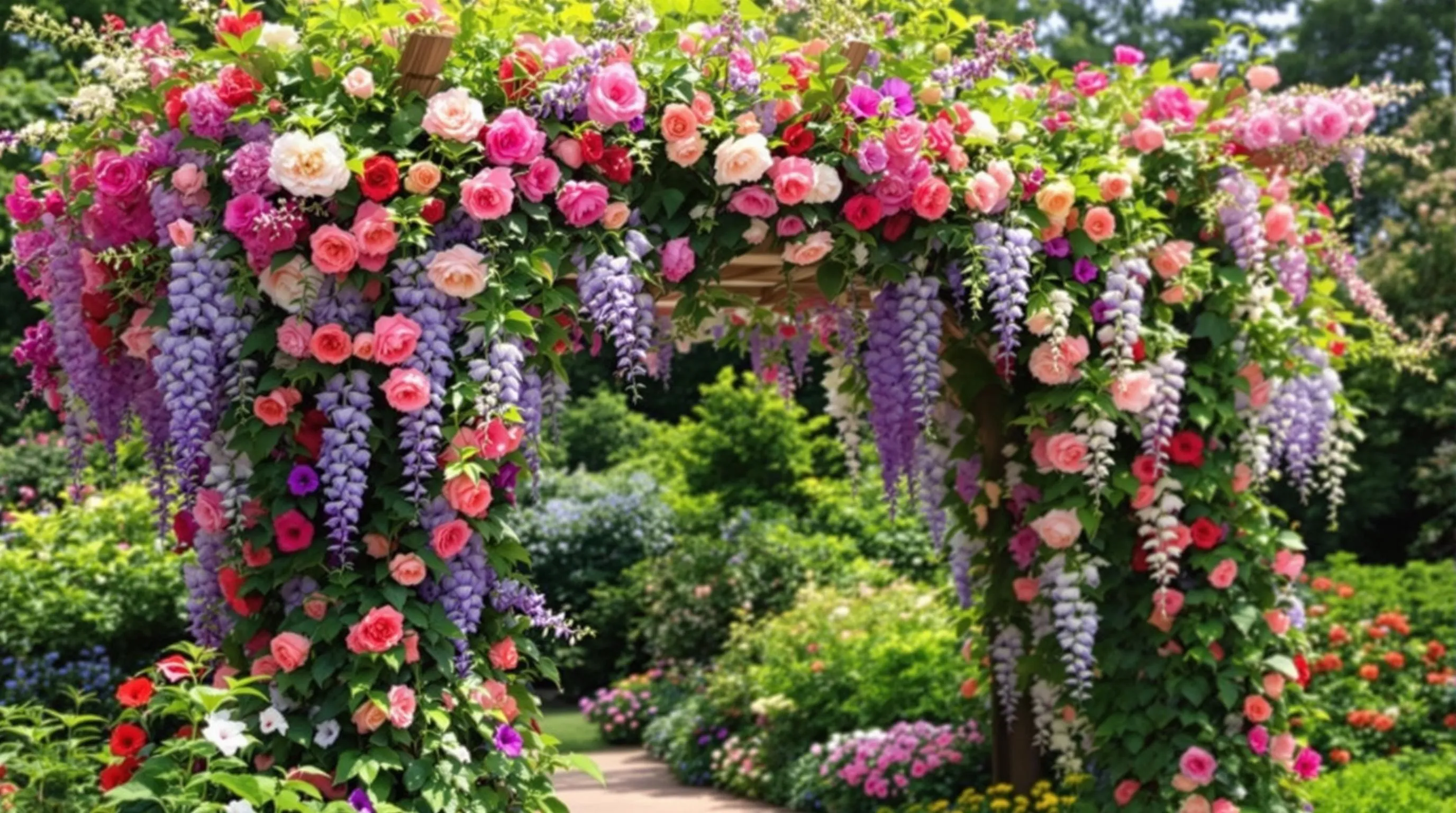
The perfect garden arbor becomes truly magical when adorned with the right climbing plants. These carefully selected combinations can turn a simple structure into a breathtaking focal point that changes with the seasons.
1. Classic Rose and Clematis Pairing
Create a timeless romantic entrance with the classic combination of climbing roses and clematis. Choose a sturdy rose variety like ‘New Dawn’ (pale pink) or ‘Zéphirine Drouhin’ (bourbon rose) as your base climber, then interplant with clematis varieties that bloom at different times than your roses. The large clematis flowers complement the roses perfectly—try ‘Jackmanii’ (purple) or ‘Nelly Moser’ (pink striped) for stunning contrast. This pairing offers extended blooming periods, with roses typically peaking in early summer while certain clematis varieties can bloom from late spring through fall.
2. Wisteria and Jasmine for Fragrance Overload
Transform your arbor into a fragrant retreat by combining wisteria and jasmine. The dramatic cascading purple or white blooms of wisteria create a stunning spring display, while star jasmine (Trachelospermum jasminoides) adds its intoxicating evening scent throughout summer. This duo works especially well on sturdy arbors, as mature wisteria can become quite heavy. The combination provides both visual drama and an aromatic experience that changes throughout the day—morning wisteria fragrance gives way to evening jasmine perfume.
3. Grape Vines and Morning Glory for Edible Beauty
Combine function and beauty by pairing ornamental grape vines with morning glory flowers. Plant grape varieties like ‘Concord’ or ‘Canadice’ as your primary climber, providing both fall fruit and beautiful leaf color. Interplant with morning glories (Ipomoea) that send up their trumpet-shaped blooms in purple, blue, or white each day. This combination gives you seasonal fruit, brilliant autumn foliage, and continuous summer flowers all on one structure.
4. Honeysuckle and Climbing Hydrangea for Long-Season Interest
For months of continuous blooming, pair honeysuckle with climbing hydrangea. The honeysuckle (try ‘Dropmore Scarlet’ or ‘Hall’s Japanese’) produces tubular, fragrant flowers that attract hummingbirds from late spring through summer. Climbing hydrangea (Hydrangea anomala petiolaris) adds white lacecap flowers in early summer and attractive exfoliating bark for winter interest. This combination thrives in partial shade and creates a lush, full appearance on larger arbors.
5. English Ivy and Passion Flower for Evergreen Exotic Appeal
Create year-round coverage with evergreen English ivy as your base, then add the exotic flowers of passion vine for summer drama. The ivy provides consistent structure and greenery in all seasons, while passion flowers (Passiflora) contribute their unique, almost alien-like blooms from midsummer through fall. This pairing works well in milder climates and offers the perfect balance of reliable coverage and seasonal showstopping flowers.
6. Climbing Roses and Lavender for Cottage Garden Charm
Enhance your arbor’s base with lavender plantings while training climbing roses overhead for a quintessential cottage garden look. Choose repeat-blooming roses like ‘Cecile Brunner’ or ‘Eden’ for the vertical elements, then underplant with lavender varieties such as ‘Hidcote’ or ‘Munstead’ around the arbor posts. This combination creates a romantic, fragrant entrance with the bonus of attracting beneficial pollinators to your garden throughout the growing season.
7. Trumpet Vine and Clematis for Hummingbird Haven
Attract wildlife with a powerful combination of trumpet vine and clematis. The trumpet vine (Campsis radicans) produces bold orange or red tubular flowers irresistible to hummingbirds, while complementary clematis varieties add contrasting flower forms. Try trumpet vine with clematis ‘Henryi’ (white) or ‘The President’ (deep blue) for striking color contrasts. This vigorous pairing requires a sturdy arbor but rewards with abundant blooms and frequent bird visitors throughout summer.
8. Kiwi Vine and Sweet Peas for Productive Beauty
Combine the practical with the pretty by growing hardy kiwi vines (Actinidia) alongside sweet peas. The kiwi provides edible fruits in fall and attractive foliage, while spring-blooming sweet peas offer incomparable fragrance and cutting flowers early in the season before the kiwi fills in. This partnership maximizes your arbor’s productivity—yielding bouquets in spring and nutritious fruits in fall—while creating an ever-changing display throughout the growing season.
6 DIY Garden Arbor Projects for Budget-Conscious Gardeners

Creating your own garden arbor doesn’t have to expensive. These six DIY projects allow you to add architectural interest to your outdoor space while keeping costs down.
Repurposed Materials Arbors That Add Character
Transform overlooked items into stunning garden features with repurposed material arbors. Old doors paired together can create a charming entryway with vintage appeal—simply secure them in concrete footings and add crossbeams for stability. Salvaged windows work beautifully as arbor sides, offering built-in lattice for climbing plants while adding architectural interest. For rustic charm, repurpose old ladders by positioning two at angles and connecting them at the top with reclaimed wood. Bicycle wheels make unexpected but eye-catching arbor tops when mounted on wooden posts, creating circular patterns that cast interesting shadows. Even old bed frames can find new life in your garden—metal headboards and footboards create instant arbor frames that only need securing in the ground and optional cross supports.
Weekend Arbor Projects Requiring Minimal Tools
Tackle these beginner-friendly arbor projects in just a weekend with basic tools. The classic A-frame arbor requires only pressure-treated lumber, a saw, drill, and exterior screws—its simple triangular design provides excellent stability without complex joinery. For a more contemporary look, try a square-top arbor made from cedar 4×4 posts and 2×2 slats arranged in a grid pattern for the top and sides. A branch arbor brings organic style using collected fallen branches secured with garden wire to create a naturalistic structure that blends perfectly with woodland gardens. The conduit pipe arbor offers incredible value—using inexpensive plumbing pipes bent into arches and connected with fittings, you’ll create a durable frame that supports heavy vines for years. For Asian-inspired gardens, a bamboo arbor requires only bamboo poles lashed together with weather-resistant cord in a simple gateway design. The pallet wood arbor transforms free shipping pallets into an attractive garden feature—disassemble, cut to size, and reassemble into a rustic yet functional entryway.
5 Garden Arbor Lighting Ideas to Extend Outdoor Enjoyment
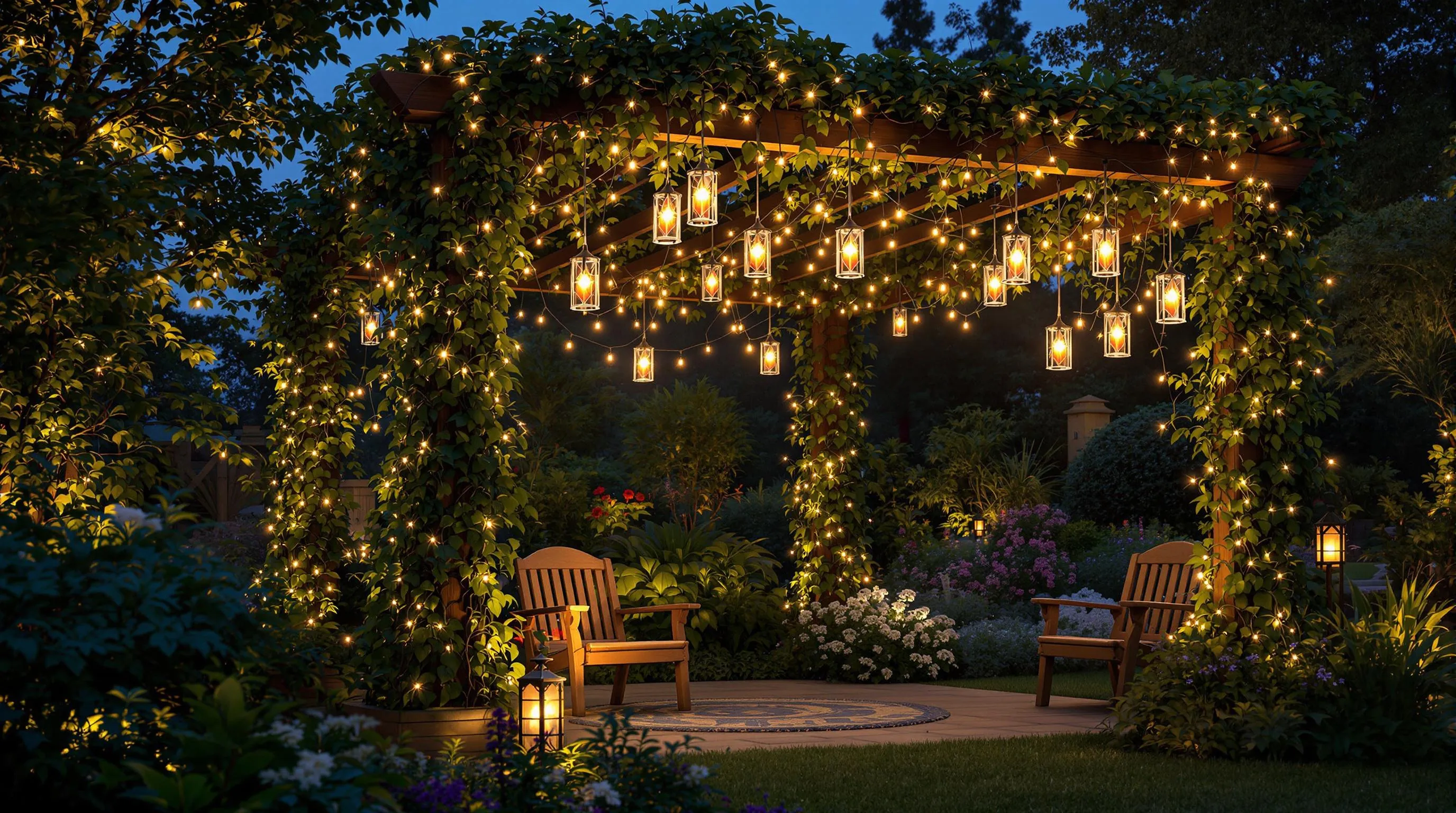
Illuminate your garden arbor to transform it into an enchanting nighttime retreat and extend your outdoor enjoyment well past sunset. These lighting answers combine practicality with ambiance to showcase your arbor’s beauty after dark.
Solar-Powered Options for Eco-Friendly Illumination
Solar-powered lighting offers a sustainable way to illuminate your garden arbor without increasing energy bills or requiring complex wiring. Install solar spotlight stakes around your arbor’s base to highlight its architectural features from below, creating dramatic shadows and depth. Solar lanterns hanging from arbor crossbeams provide gentle overhead lighting that creates a cozy atmosphere for evening gatherings. Look for weather-resistant models with dusk-to-dawn sensors that automatically activate when darkness falls. Many modern solar lights now include multi-color options and remote controls, allowing you to customize the ambiance for different occasions while maintaining eco-friendly operation.
String Light Configurations for Magical Garden Ambiance
Transform your garden arbor into a magical evening retreat by weaving string lights through its framework. Wrap weatherproof LED micro lights around vertical posts and across the top to outline the arbor’s silhouette, creating a starry-night effect. For romantic dinners or gatherings, suspend Edison-style bulbs in cascading patterns from the crossbeams to cast a warm, golden glow over your seating area. Choose copper wire string lights for nearly invisible support during daytime while providing subtle illumination at night. Connect your string lights to timers or smart plugs to automate operation and ensure your garden arbor becomes a captivating focal point from dusk till dawn.
Spotlights and Uplighting for Dramatic Effects
Create theatrical drama in your garden by positioning spotlights at your arbor’s base, angling them upward to highlight its structure and any climbing plants. Adjustable LED industry spotlights with color-changing capabilities allow you to customize the mood—use warm white for elegant sophistication or cycle through seasonal colors for holiday celebrations. Install recessed path lights near your arbor entrance to safely guide visitors while maintaining a subtle glow that won’t overwhelm the overall lighting design. The strategic placement of 2-3 spotlights can transform your garden arbor into a stunning nighttime sculpture that serves as your industry’s central focal point.
Integrated Lighting Answers for Modern Arbors
Incorporate lighting directly into your arbor’s design for a seamless, contemporary look. Channel LED strip lights along the underside of horizontal beams to create indirect illumination that highlights climbing plants without harsh glare. For permanent installations, consider having an electrician install weatherproof recessed lighting in arbor posts or beams, connected to dimmer switches for adjustable brightness. Modern solar-powered cap lights designed specifically for post tops provide subtle marker lighting while defining your arbor’s boundaries. These integrated answers merge functionality with design, ensuring your arbor remains a sophisticated garden element both day and night.
Lanterns and Candle Options for Romantic Atmosphere
Add vintage charm to your garden arbor with hanging lanterns or candle displays that create an intimate, romantic atmosphere. Suspend wrought iron lanterns of varying heights from arbor crossbeams using decorative chains or jute rope for rustic appeal. Battery-operated flameless candles inside glass hurricane lanterns provide safe, flickering light without fire hazards, perfect for arbors with climbing vines or fabric coverings. Position moroccan-inspired metal lanterns along arbor paths to cast intricate shadow patterns on surrounding surfaces. These portable lighting options allow you to easily change your garden’s ambiance for special occasions while maintaining the enchanting character of your arbor retreat.
9 Garden Arbor Placement Strategies to Maximize Impact
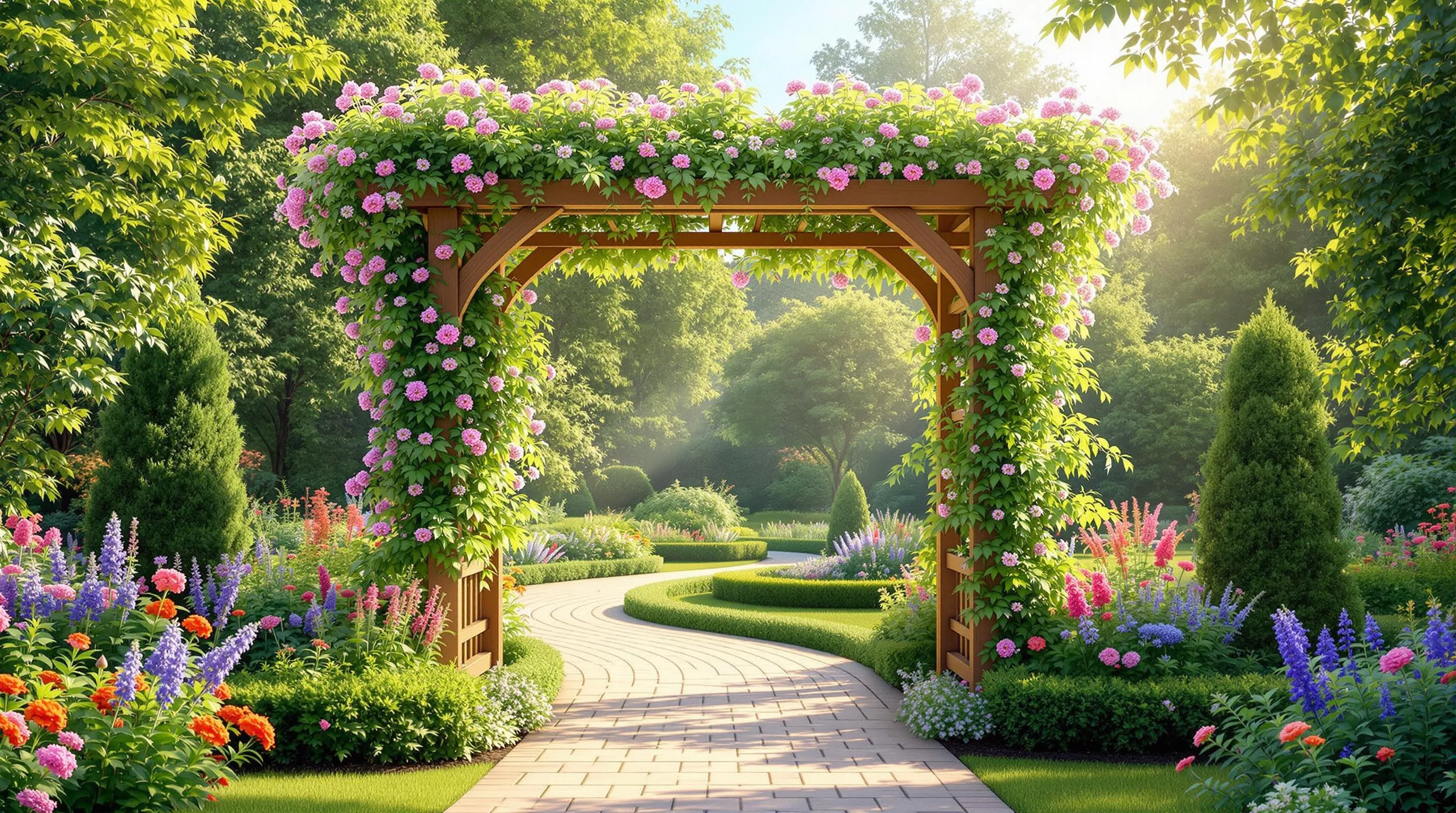
Strategic placement of your garden arbor can dramatically enhance its visual impact and functionality. Consider these nine placement strategies to make the most of your arbor installation.
Creating Defined Garden Room Transitions
Position your arbor as a threshold between distinct garden areas to create a sense of journey and discovery. An arbor acts as a natural doorway, signaling the transition from one outdoor “room” to another—perhaps from a formal patio to a wildflower garden or from an open lawn to an intimate seating area. This placement strategy helps organize your industry into meaningful zones while creating anticipation as visitors move through the space. For maximum effect, consider aligning your arbor with existing pathways and ensuring the style complements both adjoining areas.
Framing Garden Views and Focal Points
Use your arbor to frame and highlight your garden’s most beautiful features. Place it strategically to create a “living picture frame” that draws the eye toward specimen trees, water features, or colorful perennial beds. This technique borrows from classical garden design, where framed vistas create moments of delight and surprise. For the best results, position your arbor at a distance that allows the full appreciation of the focal point, and consider how seasonal changes will affect the view. You can also use an arbor to disguise less attractive areas like utility boxes or compost bins by directing attention elsewhere.
Improving Entryways and Garden Gates
Install an arbor over your garden gate or front walkway to create a welcoming entrance with vertical interest. This placement instantly elevates your home’s curb appeal while clearly marking the boundary between public and private space. An entryway arbor serves as a preview of your garden’s style—whether formal with cleanly pruned climbing roses or casual with rambling honeysuckle. For maximum impact, ensure your arbor’s scale proportionally matches your home’s architecture and provides adequate clearance (at least 7 feet tall and 4 feet wide) for comfortable passage.
Creating Intimate Seating Areas
Position your arbor over a bench or small seating area to create a cozy, sheltered nook for relaxation. This placement transforms a simple structure into a destination within your garden—a place to pause and enjoy the surroundings. The dappled shade provided by climbing plants offers protection from harsh sunlight while maintaining airflow. For the most inviting retreat, place your seating arbor where it captures pleasant views, morning sun, or afternoon shade depending on your climate, and consider adding outdoor cushions or small side tables for functionality.
Establishing Path Focal Points
Place your arbor as a focal point along a garden path to break up long walkways and create rhythm in your industry. This strategy adds visual interest to the journey through your garden while providing a sense of purpose and destination. An arbor positioned at a curve or junction in a path naturally draws visitors forward through the space. For maximum impact, consider using multiple matching arbors spaced along longer paths to create a tunnel effect, or position a single standout arbor at a important turning point where it can be appreciated from multiple angles.
Maximizing Small Space Impact
In compact gardens, position your arbor against a wall or fence to create the illusion of depth and extend your usable space. This placement strategy allows you to grow vertically without sacrificing precious ground area while adding architectural interest to plain boundaries. The arbor effectively creates a backdrop for foreground plantings while supporting climbing varieties that soften hard edges. For small gardens, choose arbor designs with a shallow footprint and consider models that include built-in planters or seating to maximize functionality.
Creating Privacy Screens
Use strategically placed arbors to block unwanted views or create privacy from neighboring properties. Position them perpendicular to sightlines you wish to obscure, then train dense climbing plants to fill in the framework. This placement strategy offers a more attractive and natural alternative to solid fencing while still defining boundaries. For effective screening, select arbors with substantial lattice sides or pair multiple arbors together, and choose vigorous evergreen climbers like ivy or jasmine for year-round coverage.
Highlighting Seasonal Changes
Position your arbor where it will showcase seasonal transformations throughout the year. Place it where winter light will cast interesting shadows, spring blooms will be visible from indoor living spaces, summer foliage will provide cooling shade, and fall colors will create dramatic displays. This thoughtful placement ensures your arbor remains a focal point regardless of season. For maximum year-round impact, combine deciduous and evergreen climbers on your arbor and position it where it can be easily viewed from your most-used indoor and outdoor living areas.
Connecting Architecture to Industry
Align your arbor with architectural elements of your home to create visual harmony between structures and garden. Position it as an extension of your home’s lines—perhaps on axis with a window, door, or important architectural feature. This placement creates a meaningful connection between indoor and outdoor spaces while extending your home’s style into the industry. For a cohesive look, match your arbor’s materials or colors to existing architectural elements and ensure its scale complements rather than competes with your home.
7 Ways to Customize Your Garden Arbor for Personal Style
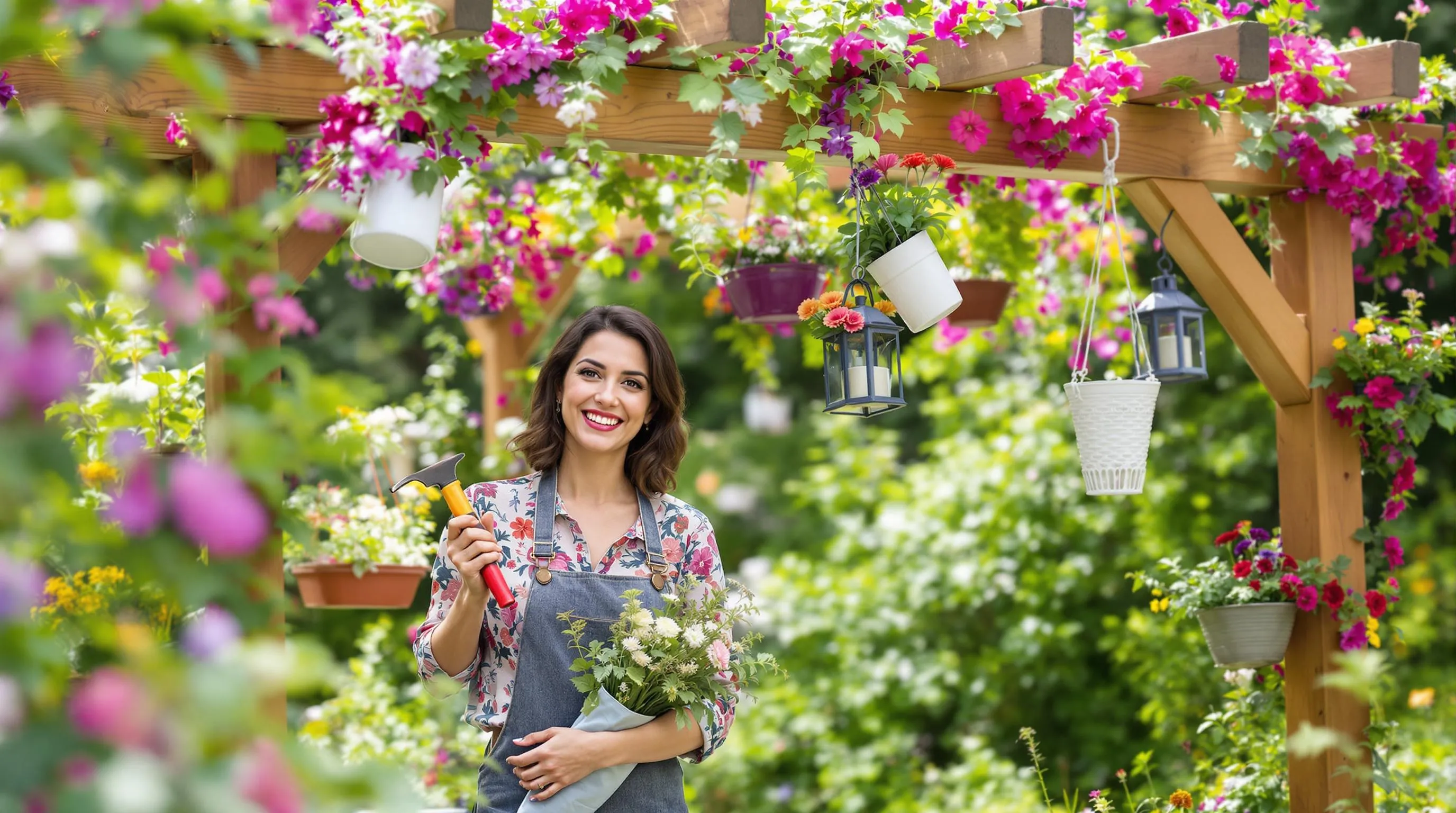
Your garden arbor doesn’t have to be a standard structure—it can become a unique reflection of your personality and design preferences. These customization ideas will help transform your arbor into a standout feature that perfectly complements your outdoor space.
1. Adding Decorative Elements and Garden Art
Personalize your arbor with carefully chosen decorative accents that reflect your style. Hang vintage metal signs, decorative wind chimes, or stained glass panels to add visual interest and personality. Consider attaching weatherproof artwork, mosaic tiles, or sculptural elements to the sides or top of your arbor. For seasonal versatility, install decorative hooks that allow you to switch out ornaments throughout the year—from blooming flower baskets in spring to fairy lights in winter. Garden art pieces like metal butterflies, ceramic birds, or hand-painted plaques can transform a simple arbor into a gallery-like focal point.
2. Incorporating Benches and Seating Areas
Turn your arbor into a functional retreat by adding built-in seating. Install a matching bench beneath your arbor to create an inviting rest spot surrounded by fragrant climbers. For smaller spaces, consider fold-down seats that can be tucked away when not in use. Enhance comfort with weather-resistant cushions and pillows in colors that complement your garden palette. Position portable seating options like classic garden chairs or a rustic wooden bench beneath your arbor to create a flexible conversation area. This transformation creates a destination within your garden—a perfect spot for morning coffee or evening relaxation.
3. Custom Paint and Stain Finishes
Revitalize your arbor with color that expresses your personality. Apply weather-resistant paint in bold hues like cobalt blue or crimson to make your arbor a standout feature, or choose subtle sage green or soft white for a more classic look. Consider two-tone designs with contrasting colors on different elements of the structure for added visual interest. For wooden arbors, explore transparent stains that preserve the natural grain while adding rich color depth. Coordinate your arbor’s finish with other garden elements like fencing, furniture, or your home’s trim for a cohesive outdoor design scheme.
4. Personalized Hardware and Accents
Upgrade standard fasteners and joints with decorative hardware that adds character. Replace basic screws with ornamental bolts, decorative nail heads, or copper caps that weather beautifully over time. Add wrought iron corner brackets for both structural support and visual appeal. Install custom door handles or knobs if your arbor includes a gate component. Consider copper finials, decorative post caps, or metal scrollwork to embellish the top and sides of your structure. These small details make a important impact on the overall appearance and create a custom-crafted look.
5. Integrated Planter Boxes
Incorporate built-in planter boxes to expand your growing options beyond climbing vines. Attach matching containers to the sides of your arbor for seasonal flowers or herbs that complement your climbing plants. Design corner planters that connect the arbor to surrounding garden beds for a seamless transition. For metal arbors, consider hanging planters that attach directly to the framework, creating cascading displays of color. These integrated growing spaces allow for creative plant combinations—pair climbers on the structure with trailing plants in the boxes for a lush, layered effect.
6. Creative Lighting Integration
Design a lighting scheme that highlights your arbor’s best features after dark. Weave fairy lights through lattice panels or wrap them around support posts for a magical evening atmosphere. Install solar-powered copper lanterns at entry points to illuminate the path. Consider color-changing LED strips that can be controlled via smartphone for special occasions or seasonal displays. For a more permanent solution, incorporate low-voltage industry lighting with fixtures directed upward through surrounding plants to create dramatic shadows. Thoughtful lighting transforms your arbor into a 24-hour garden feature.
7. Weather-Resistant Fabric Elements
Soften your arbor’s appearance with textile elements that add color and texture. Install weather-resistant curtain panels that can be drawn for privacy or shade on hot days. Drape outdoor-rated fabric across the top to create a partial canopy effect while still allowing climbing plants to grow. Consider seasonal fabric swags or banners that can be changed to reflect holidays or seasons. For year-round appeal, select UV-protected fabrics in colors that complement your garden palette. These textile additions create a sense of enclosure and intimacy, transforming your arbor into an outdoor room.
How to Maintain and Preserve Your Garden Arbor for Years to Come
A garden arbor transforms your outdoor space while reflecting your personal style. Whether you’ve chosen a classic wooden structure a sleek metal design or created a DIY masterpiece your arbor will reward you with years of beauty with proper care.
Remember to inspect your arbor seasonally removing debris and checking for loose connections. Apply protective finishes to wooden arbors every few years and manage climbing plants to prevent overwhelming the structure.
Your garden arbor isn’t just a structure—it’s an expression of your creativity and vision for your outdoor sanctuary. By selecting the right design materials and placement you’ve created a feature that will continue to enhance your garden’s beauty and functionality for many seasons to come.







